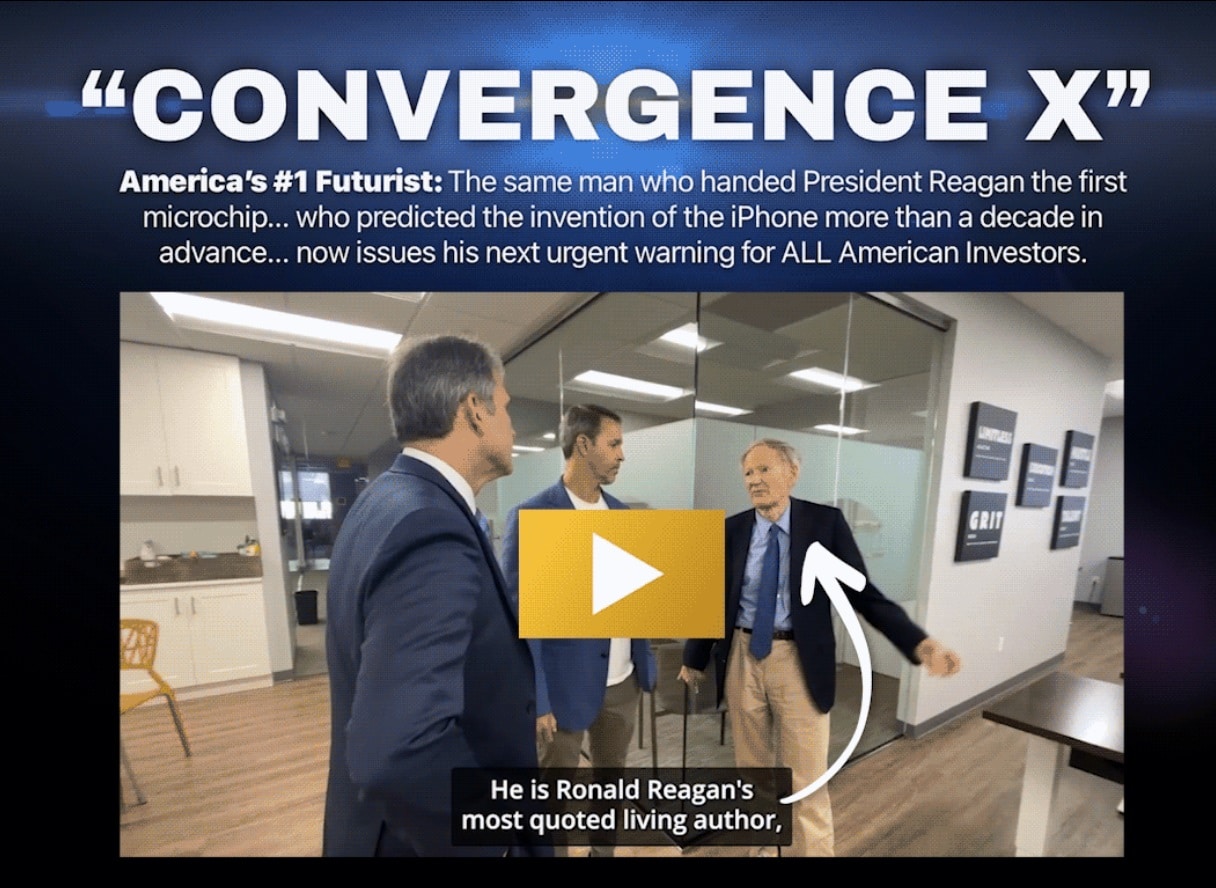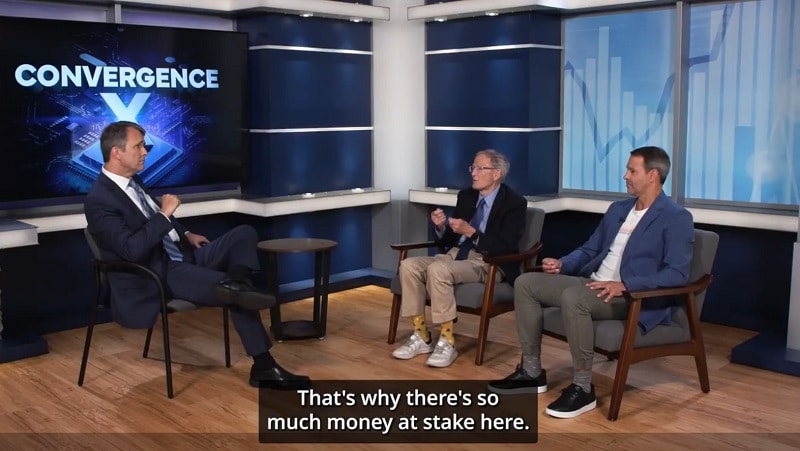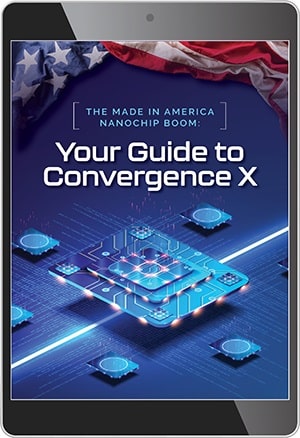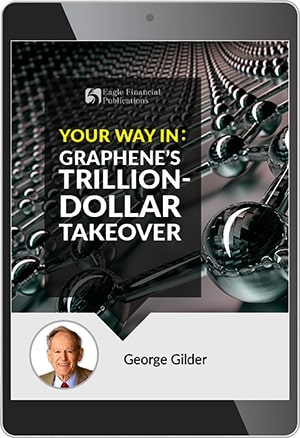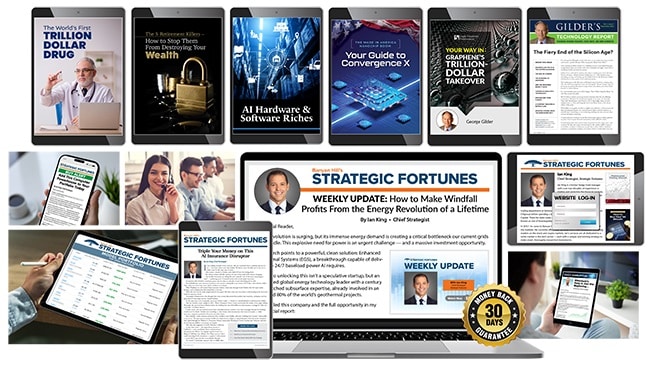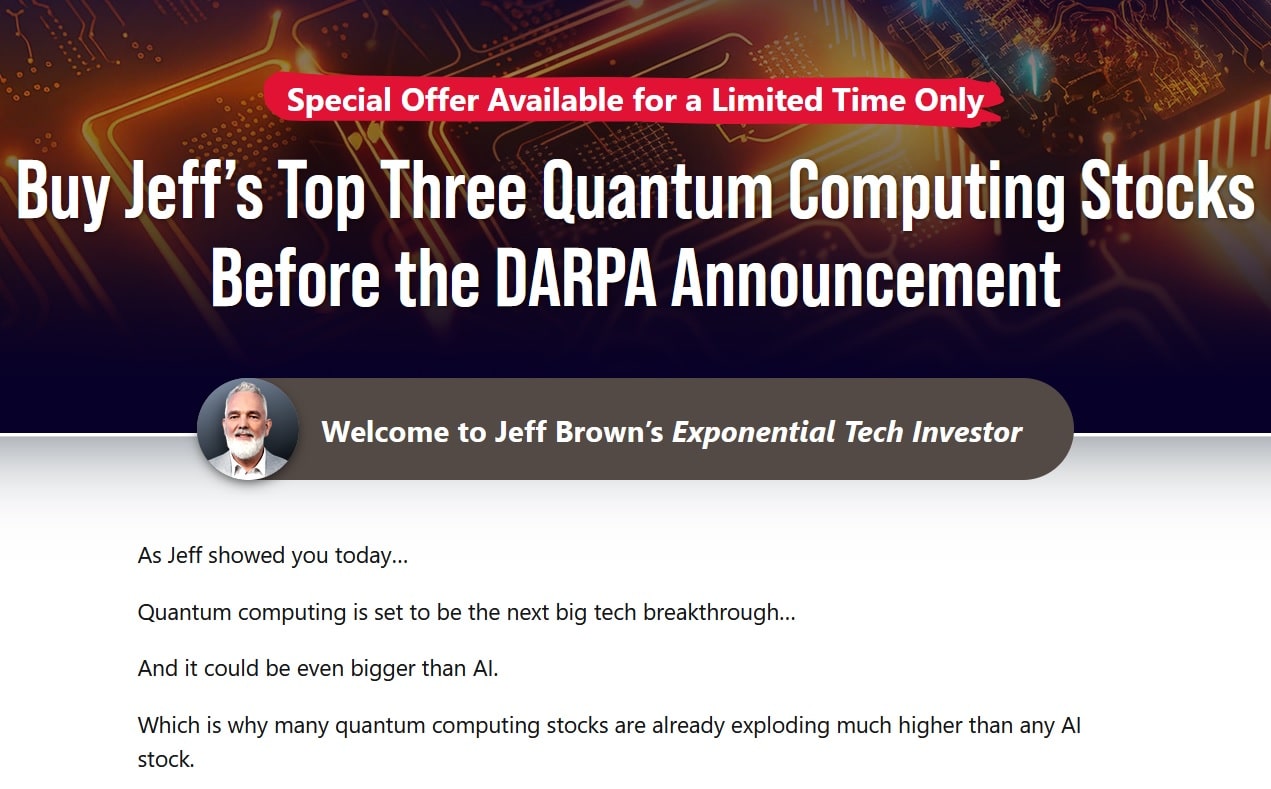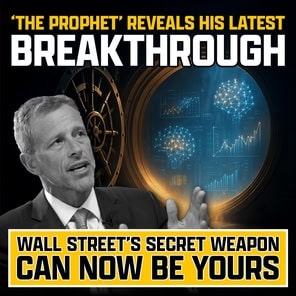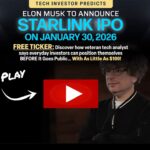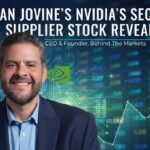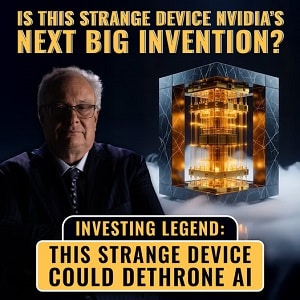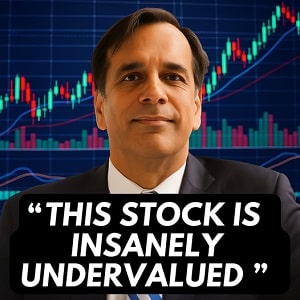In the ever-evolving landscape of technological innovation, few voices carry the weight of authority like George Gilder and Ian King.
Gilder, the legendary futurist who once handed President Ronald Reagan a microchip in 1983 and predicted the digital revolution that followed, has spent decades forecasting the seismic shifts that propel economies forward.
King, a battle-tested hedge fund manager turned chief strategist at Banyan Hill Publishing, brings a sharp eye for tipping-point trends in emerging tech. Together, they’ve ignited a firestorm of investor interest with their bold vision of “Convergence X”—a supercharged fusion of nanochips, artificial intelligence (AI), robotics, and revolutionary materials like graphene that’s poised to eclipse even the internet’s transformative power.
This isn’t hyperbole. As of today, Convergence X is no longer a distant horizon; it’s barreling toward us, with milestones like TSMC’s Arizona facilities already churning out the world’s most advanced nanochips on U.S. soil. Trillion-dollar titans like Nvidia, Apple, and TSMC are pouring billions into this ecosystem, signaling a manufacturing renaissance that’s repatriating over $1 trillion in production to America.
But amid the hype, one question burns brightest: What are the “Convergence X” stocks Gilder and King are teasing—those hidden gems ready to rocket as this revolution unfolds?
The answer? It’s locked behind the doors of Strategic Fortunes, King’s flagship newsletter that’s empowered over 100,000 subscribers worldwide—from Wall Street insiders at Goldman Sachs and Morgan Stanley to everyday investors chasing generational wealth.
In this comprehensive deep dive, we’ll unpack the full story of Convergence X: its historical roots, explosive mechanics, and why it’s the investment opportunity of our lifetime.
We’ll explore Gilder’s prophetic track record, King’s battle-tested strategies, and the irresistible offer that’s making headlines. But remember—the specific stock names, detailed buy/sell guidance, and model portfolio access? Those are subscriber exclusives. If you’re ready to position yourself ahead of 99% of Americans blind to this boom, keep reading. Your path to the trillion-dollar takeover starts here.
The Prophet of Progress: George Gilder’s Enduring Legacy in Tech Forecasting
To grasp Convergence X, we must first honor its intellectual architect: George Gilder. Born in 1939, Gilder isn’t just an economist or investor—he’s a philosopher of abundance, a supply-side pioneer whose ideas reshaped modern capitalism. His 1981 bestseller Wealth and Poverty became the blueprint for Reaganomics, arguing that low taxes and free markets unleash human creativity, driving exponential growth. But Gilder’s true genius lies in his prescience for technology’s role in that equation.
Picture this: In 1983, Gilder strides into the Oval Office, places a tiny silicon chip on Reagan’s desk, and declares, “This will change the world.” He was right. That microchip sparked the personal computing era, birthing icons like Apple and Microsoft. Gilder’s subsequent works—Microcosm (1989), which dissected the quantum roots of semiconductors; Life After Television (1990), foreseeing portable, voice-activated devices (hello, smartphones); and Telecosm (2000), prophesying infinite bandwidth and the internet’s “crystalline web of glass and light”—cemented his status as the “world’s #1 technology futurist.”
Gilder’s philosophy? Low entropy drives progress. In information theory terms (drawn from Claude Shannon’s groundbreaking work), he posits that economies thrive when “waste what’s abundant to make up for what’s scarce.” Bits of data are cheap; creativity is infinite. This mindset fueled his early calls on Qualcomm and Amazon in the 1990s, turning readers into multimillionaires. Yet, Gilder’s not infallible—his 2000 dot-com enthusiasm led to some painful lessons, like overhyping fiber-optic plays amid the bust. But as Forbes noted in 2013, Gilder “returns bearing knowledge and power,” his visions refined by adversity.
Fast-forward to 2025: At 85, Gilder’s sharper than ever, publishing through Gilder’s Technology Report and collaborating with Banyan Hill. His latest obsession? Graphene, the “miracle material” dubbed 200 times stronger than steel, lighter than paper, and Earth’s supreme electricity conductor. In reports like Your Way In: Graphene’s Trillion Dollar Takeover (a $399 value, free to Strategic Fortunes subscribers), Gilder spotlights a company with a patent-pending process producing graphene 350,000% faster than rivals. This isn’t sci-fi—it’s the key to unlocking Convergence X’s full potential, from super-efficient batteries to unbreakable armor.
Gilder’s influence extends beyond books. As co-founder of the Discovery Institute, he’s shaped debates on intelligent design and free-market tech policy. His annual Telecosm conferences drew titans like Ray Kurzweil, blending philosophy with futurism. Today, Gilder’s warnings about Big Tech’s “nervous breakdown”—Google’s overreliance on big data, per Life After Google (2018)—echo in antitrust battles. Convergence X, he argues, is the antidote: a decentralized, creative explosion where nano-devices collide with AI, robotics, and nanomaterials to birth a $11 trillion-plus economy.
Ian King: From Hedge Fund Heavyweight to Tipping-Point Trend Hunter
Enter Ian King, Gilder’s perfect foil. If Gilder is the visionary sage, King is the street-smart tactician, translating prophecies into profitable plays. With over 20 years in finance—including stints at Salomon Brothers, Citigroup (analyzing multimillion-dollar deals), and Peahi Capital (where he delivered outsized returns amid the 2008 crash)—King knows volatility intimately. He’s traded currencies, managed hedge funds, and even built Investopedia Academy’s first crypto course. But King’s edge? His proprietary four-step system for spotting “tipping-point trends”: massive tech shifts that cascade into industry disruptions.
King’s track record speaks volumes. In 2024, his Palantir (PLTR) call soared 350%, while Luna (LUNA) delivered 18,000% gains in prior years. Tesla (TSLA) and SolarEdge (SEDG) were early wins, netting subscribers triple-digit returns. As chief strategist for Banyan Hill’s Strategic Fortunes (formerly Automatic Fortunes), King focuses on overlooked disruptors in AI, 5G, EVs, and now nanochips. His mantra: “Invest in what could become America’s biggest wealth boom since the dawn of the microchip.”
King’s collaboration with Gilder isn’t accidental. Both see history as a series of convergences—rare moments when technologies amplify each other exponentially. In their joint presentation (viewed by millions since September 2025), they warn: Starting any day from now, Convergence X ignites. U.S. robotics investments hit $38 billion, humanoid bots signal AI’s leap, and TSMC’s Arizona plants herald a “Made in America” nanochip surge. King’s role? Distilling this into actionable intel via Strategic Fortunes, where subscribers get monthly picks, trade alerts, and a model portfolio tracking every open position.
With over 100,000 global subscribers—including pros at Merrill Lynch—Strategic Fortunes isn’t day-trading frenzy (just 1-2 trades monthly). It’s a risk-free gateway to King’s ecosystem: weekly market updates, the free Daily Disruptor e-letter on high-tech ideas, and bonuses like The Edge for wealth protection. As King puts it, “We’ve shown you the facts. Now’s the time to act fast.”
Decoding Convergence X: The Super Convergence That’s Bigger Than the Internet
What exactly is Convergence X? Gilder and King describe it as the first “super convergence”—not one tech revolution, but several colliding at once. Past convergences minted fortunes: The microchip-PC boom (1980s) birthed Microsoft; the internet-PC fusion (1990s) exploded Amazon and Google. Each followed Gilder’s Law: Bandwidth doubles every nine months, outpacing Moore’s Law (transistors double every 18-24 months).
Convergence X ups the ante. It merges:
- Nanochips: Shrinking to 2nm by 2028 (per TSMC’s roadmap), these power AI’s insatiable data hunger. TSMC’s Phoenix fabs, fueled by $6.6B in CHIPS Act grants, started 4nm production in early 2025—yields 4% higher than Taiwan’s. U.S. output? From 0% to 20% of global leading-edge logic by 2030. Nvidia’s $65B infrastructure bet and Apple’s onshoring underscore the stakes.
- AI and Agentic Systems: 2025 is “agentic AI’s” year, per King—autonomous agents that “feed off each other,” per Gilder. Zuckerberg’s Meta and Bezos’ Amazon are liquidating billions for convergence plays. Robotics? A $38B humanoid market signals labor’s overhaul.
- Graphene and Nanomaterials: Gilder’s “miracle material” revolutionizes conductivity—200x steel’s strength, diamond-hard yet flexible. Applications? Faster EV charging, cooler AI data centers, self-healing muscles. One teased company scales production from waste, slashing costs.
This trifecta isn’t theoretical. China’s “Robot Olympics” and U.S. manufacturing resurgence (over $1T repatriated) prove it. As Gilder notes in The Israel Test (echoing his growth philosophy), envy fuels opposition—but creativity wins. Convergence X could create more millionaires than the PC-internet duo, per their estimates: $11T+ macroeconomic impact.
Risks? Geopolitics (Taiwan tensions), supply chain snarls, and overhyping (dot-com echoes). Yet, Gilder and King’s data-driven case—TSMC’s A16 tech, Nvidia partnerships—outweighs them. As Nano Convergence journal highlights, nanoscale fusion drives “new scientific areas and research opportunities.”
The Made in America Nanochip Boom
At Convergence X’s core? The nanochip renaissance. Semiconductors aren’t just chips—they’re the brainstems of modern life: smartphones, self-driving cars, AI servers. But for decades, 92% of advanced production huddled in Asia, vulnerable to disruptions (COVID shortages cost $240B).
Enter the CHIPS and Science Act (2022): $52.7B to onshore fabs. TSMC’s Arizona “gigafab” cluster—six plants, two packaging facilities, R&D hub—exemplifies it. Fab 1: 4nm chips now, ramping to 30,000 wafers/month. Fab 2: 2nm by 2028. Total investment? $65B, yielding tens of millions of logic chips for U.S. firms like AMD and Qualcomm.
This “Made in America” pivot isn’t altruism. Biden’s Raimondo calls it a “milestone”—U.S. soil now hosts the world’s most advanced tech. Benefits? Shorter supply chains, 50,000+ jobs, innovation hubs like Sonoran Oasis Park. King’s Special Report #1: The Made in America Nanochip Boom (free with subscription) teases three “best-in-class” companies poised to surge: Firms controlling nanochip tech for U.S. smartphones, EVs, and AI. Expect trillions in repatriated manufacturing; these picks could “soar as Convergence X accelerates.”
Graphene: The Miracle Material Fueling Trillion-Dollar Dreams
No Convergence X discussion omits graphene. Isolated in 2004 (Nobel-winning scotch-tape method), this single-layer carbon sheet is Gilder’s obsession. Properties? 200x stronger than steel, lighter than aluminum, best thermal/electrical conductor ever. The Guardian dubs it “Miracle Material”; Gilder sees an “Aluminum Moment”—when scarcity flips to abundance, prices plummet, adoption explodes.
Challenges? Production was slow, costly, low-quality. Enter Gilder’s teased innovator: A patent-pending process from waste (food scraps, e-waste) yields graphene 350,000% faster. Scalable? From batteries (quicker charges, 40% more energy) to armor (lightweight ballistic shields) and filters (uranium/arsenic removal). Macro impact? $11.5T, per Gilder—transforming EVs, data centers, medicine.
King’s Special Report #2: Your Way In: Graphene’s Trillion Dollar Takeover lays it bare: How to stake your claim before militaries and tech giants hoard supplies. As Nano Convergence (impact factor 10.61) notes, graphene’s “convergence with nanomedicine” enables targeted drug delivery. Gilder warns: 27 countries will fight for it. Early movers win big.
Convergence X’s Disruptive Ripples: AI, Robotics, and Beyond
Convergence X amplifies across sectors:
- AI Hardware/Software: Agentic AI (self-improving systems) demands nanochips. Zuckerberg’s $65B, Bezos’ billions signal structural bets. King’s bonus report AI Hardware & Software Riches (annual subscriber freebie) explores this.
- Robotics Revolution: $38B humanoid market (2025) converges nanochips with AI for “smarter, faster” bots. U.S. investments surge; China’s ambitions lag in quality.
- EVs and Energy: Graphene batteries charge faster, run cooler. Ties to King’s EV picks.
Broader implications? Economic: 20% U.S. chip share by 2030. Geopolitical: Reduced Taiwan risk. Societal: Abundance eases scarcity, per Gilder’s ethos.
Strategic Fortunes: Your Gateway to Convergence X Profits
Why subscribe? Strategic Fortunes democratizes Gilder-King wisdom. For $49 (first 3 months; renews $99/quarter) or $297/year (saves $$$, adds bonuses), you get:
- Monthly Newsletter: In-depth analysis, one top pick/month.
- Model Portfolio: Track all opens, targets, performance (+63.5% vs. S&P’s 43%).
- Trade Alerts: Email/text/push for 1-2 moves/month.
- Website Access: BanyanHill.com hub.
- Weekly Updates: Market insights, Q&A.
- Free E-Letters: Daily Disruptor (King’s high-tech ideas), The Edge (growth/protection), Daily Catalogue (wealth/health reports), Gilder’s Guideposts.
- Bonuses: 3 months free Gilder’s Technology Report ($249/year). Special Report #1 ($399): Nanochip plays. Special Report #2 ($399): Graphene guide. Annual adds The World’s First TRILLION DOLLAR DRUG, The 5 Retirement Killers, AI Hardware & Software Riches ($1,197 value).
100% satisfaction guarantee: 30-day money-back. Customer care? Real humans.
Conclusion: Secure Your Stake in the Next Great Convergence
George Gilder and Ian King’s Convergence X isn’t a pitch—it’s a blueprint for the post-silicon age. Nanochips on American soil, graphene’s miracle scalability, AI’s agentic leap: This super convergence could dwarf the internet, minting millionaires in its wake. But knowledge alone profits nothing; action does.
Strategic Fortunes hands you the keys: Reports, alerts, portfolio— all for pennies on the dollar. Choose 3-month ($49) or annual ($297). Nothing to lose; trillions to gain. Join 100,000+ visionaries. Let’s ride this wave together—your future self will thank you.
Frequently Asked Questions About George Gilder and Ian King’s “Convergence X” and Strategic Fortunes
What is Convergence X?
Convergence X is a term coined by George Gilder and Ian King to describe a historic “super convergence” of transformative technologies, including nanochips, artificial intelligence (AI), robotics, and graphene. This fusion is expected to disrupt industries like smartphones, electric vehicles, and AI devices, potentially creating a $11 trillion-plus economic impact and minting new millionaires.
Who are George Gilder and Ian King?
George Gilder is a renowned technology futurist, economist, and author of Wealth and Poverty and Life After Google. He’s known for predicting the microchip and internet revolutions. Ian King is a former hedge fund manager and chief strategist at Banyan Hill Publishing’s Strategic Fortunes, with a track record of triple-digit investment gains in AI, crypto, and EVs.
What is Strategic Fortunes?
Strategic Fortunes is Ian King’s flagship investment newsletter at Banyan Hill Publishing, serving over 100,000 subscribers globally. It provides monthly stock recommendations, trade alerts, a model portfolio, weekly market updates, and exclusive reports, focusing on disruptive tech trends like Convergence X.
What are the specific “Convergence X” stocks?
The specific stocks tied to Convergence X are revealed only to Strategic Fortunes subscribers in two special reports: The Made in America Nanochip Boom: Your Guide to Convergence X and Your Way In: Graphene’s Trillion Dollar Takeover. These reports detail three nanochip companies and one graphene innovator, but names are exclusive to subscribers.
What do I get with a Strategic Fortunes subscription?
For a 3-month subscription ($49, renews at $99/quarter) or annual ($297, renews annually), you receive:
- Monthly newsletter with one top stock pick.
- Access to Ian King’s model portfolio.
- Trade alerts (1-2 per month) via email, text, or app notifications.
- Weekly market updates and Q&A.
- Access to BanyanHill.com for all resources.
- Free e-letters: Daily Disruptor, The Edge, Daily Catalogue, and Gilder’s Guideposts.
- Special Report #1: The Made in America Nanochip Boom ($399 value).
- Special Report #2: Your Way In: Graphene’s Trillion Dollar Takeover ($399 value).
- Annual bonus reports: The World’s First TRILLION DOLLAR DRUG, The 5 Retirement Killers, AI Hardware & Software Riches ($1,197 total value).
- 3 months free of Gilder’s Technology Report ($249 value).
- World-class customer support.
- 30-day money-back guarantee.
How does the 30-day money-back guarantee work?
If you’re not satisfied within the first 30 days, you can request a full refund, no questions asked. Contact Banyan Hill’s customer care team to process your refund and ensure a hassle-free experience.
What is the significance of nanochips in Convergence X?
Nanochips, shrinking to 2nm by 2028, are the backbone of Convergence X, powering AI, robotics, and smartphones. TSMC’s Arizona facilities, backed by the CHIPS Act, are producing advanced 4nm chips in 2025, marking a U.S. manufacturing renaissance with over $1 trillion in repatriated production.
Why is graphene called a “miracle material”?
Graphene, highlighted by George Gilder, is 200 times stronger than steel, lighter than paper, and the best conductor of electricity. Its applications include faster-charging EV batteries, lightweight armor, and advanced medical devices. A company with a patent-pending process produces it 350,000% faster, unlocking trillion-dollar potential.
Can I access Strategic Fortunes if I’m not in the U.S.?
Yes, Strategic Fortunes has over 100,000 subscribers in 100+ countries. All resources, including reports, newsletters, and alerts, are accessible online via BanyanHill.com or the Banyan Hill app, making it available globally.
How often are trades made in Strategic Fortunes?
Strategic Fortunes is not a day-trading service. It averages 1-2 trades per month (buys or sells), ensuring a low-maintenance approach suitable for busy investors. Trade alerts are delivered via email, text, or app notifications.
What is Gilder’s Technology Report, and why is it included?
Gilder’s Technology Report is George Gilder’s flagship research service, sharing his top tech investment ideas. Strategic Fortunes subscribers get 3 months free ($249 value), providing additional insights into convergence trends and complementing Ian King’s recommendations.
How do I join Strategic Fortunes?
Visit BanyanHill official website to choose your membership: 3-month ($49) or annual ($297, includes extra reports). Complete the secure checkout process, and you’ll receive instant access to reports, the portfolio, and all subscriber benefits.
Is Convergence X a guaranteed investment opportunity?
No investment is guaranteed. While Gilder and King cite historical convergences (e.g., PC, internet) that created massive wealth, risks like geopolitical tensions or supply chain issues exist. Strategic Fortunes provides research and guidance to maximize potential, backed by a 30-day refund policy.
How can I contact customer support?
Banyan Hill’s customer care team is available via phone or email. Visit BanyanHill.com for contact details. The team is staffed by real people dedicated to answering questions about your subscription or accessing resources.

